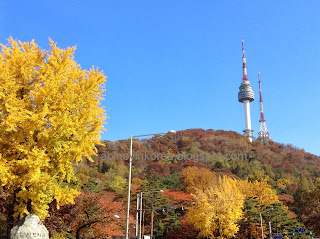In spring and summer, their leaves are green. But when the cooler temperatures of autumn descend upon Seoul, they gradually lighten up to yellow-green, and then to yellow, before they all fall off from the branches before winter.☃
The road that traces the southwestern side of Nam-san is perhaps the highest busy road in Seoul - that road from the Grand Hyatt Hotel up to the Millennium Seoul Hilton.
I don't know if Namsan is the only mountain in Seoul where, up there, public passenger buses have routes. If it is, then these roads, which have the highest elevation in the city, are also the busiest since they allow traffic to go around it. 😊
I guess, since Nam-san is the geographical center of Seoul, it was commercially viable, not just to drill tunnels through it, but to also spend a lot of money in chiseling roads around it, so that the mountain doesn't become a hindrance in connecting everyone from around city. 🚗🚌
And these views are even more conspicuous when you're up the NSeoul Tower (read blog here).
So, if you can, do swing by Namsan and trace the Gingko tree lane to enjoy Nam-san's changing of colors. 😄



























































